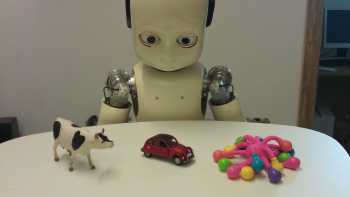01 Dec Humanoid Robot Deepens Understanding of How Toddlers Learn What Words Mean
MedicalResearch.com Interview with:
Dr Katie (Katherine) Twomey
ESRC Future Research Leaders Fellow, Lancaster University
Senior Research Associate, ESRC International Centre for Language and Communicative Development (LuCiD)
MedicalResearch.com: What is the background for this study? What are the main findings?
Response: Although we know that toddlers can quickly work out what new words mean, it’s not yet clear exactly how they do it. For example, when they see a new object alongside their favorite toy truck and hear a new word “block”, we know that they will link “block” to the new object. They could do this by thinking in detail about what they already know, for example “if my toy is called “truck”, then “block” must be the name of the new object”. Equally, however, they could quickly link the new word to the new object without thinking about it in-depth.
We tested this second possibility using iCub, a humanoid robot which learns by making quick associations between what it sees and what it hears, without the ability to think in detail about what it already knows. We replicated two studies of toddlers’ early word learning with iCub and found that even though it can only learn through making simple links between words and objects, it behaved exactly as children did in the original experiments.
MedicalResearch.com: What should readers take away from your report?
Response: The key finding of this work is that what looks like complex behaviour can emerge from simple but powerful association-making mechanisms. This suggests that children may not need to be able to reason in a complex way in order to learn their first words.
MedicalResearch.com: What recommendations do you have for future research as a result of this study?
Response: Importantly, iCub is an embodied system, so what it learns from is determined by its body interacting with the learning environment. An important insight from this work is that the amount of time it took iCub to move its head to look at objects affected how easily the robot learned those objects’ names. This suggests that the layout of children’s learning environment will impact on their early language development. We’re currently planning studies with toddlers to test this possibility.
MedicalResearch.com: Is there anything else you would like to add?
Response: This work was carried out in collaboration with Dr. Jessica Horst (University of Sussex, UK), Dr. Anthony Morse, (University of Plymouth, UK), and Prof Angelo Cangelosi (University of Plymouth, UK). It was supported by the UK Economic and Social Research Council (ES/L008955/1; ES/H014942/1) and the European Commission FP7
(Poeticon++).
MedicalResearch.com: Thank you for your contribution to the MedicalResearch.com community.
Citation:
Children’s referent selection and word learning: Insights from a developmental robotic system
Katherine E. Twomey, Anthony F. Morse, Angelo Cangelosi and Jessica S. Horst
Interaction Studies, Volume 17, Issue 1, 2016, pages: 93 –119
Published online 26 September 2016
Note: Content is Not intended as medical advice. Please consult your health care provider regarding your specific medical condition and questions.
More Medical Research Interviews on MedicalResearch.com
[wysija_form id=”5″]
Last Updated on December 2, 2016 by Marie Benz MD FAAD

